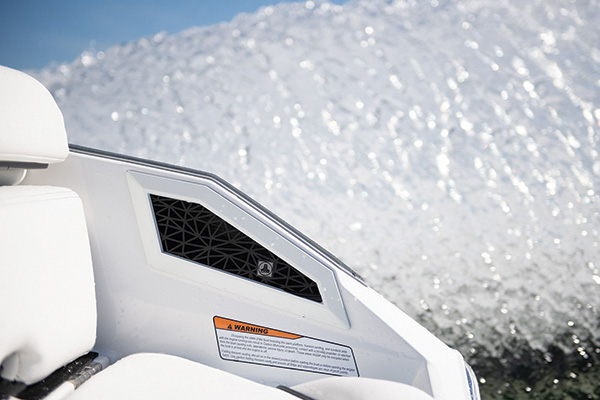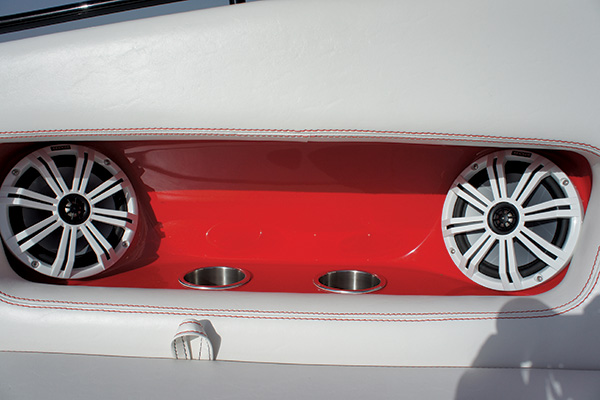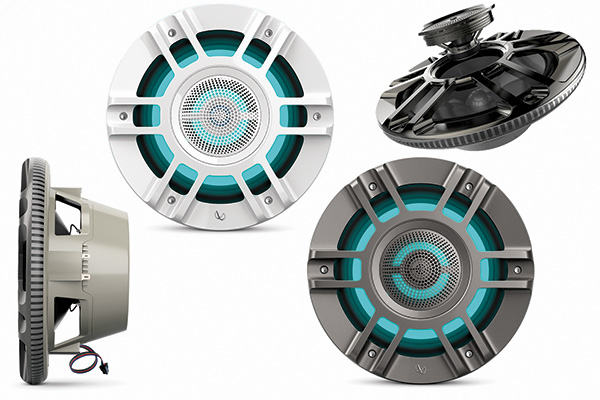Party on: Audio manufacturers bring new technologies to the water

By Adam Quandt
Traditional is by no means a word to describe the audio elements going into today’s recreational boats. Though manufacturers are still playing some forms of catch up to features often found and expected in the automotive industry, marine audio providers are working hard to keep the party going on the water.
“The expectations of consumers are way higher than they have ever been,” JL Audio director of OEM sales Ora Freeman said. “Fifteen years ago, most consumers expected to replace their systems almost every year due to the harsh marine environment. Now, systems are being built to last and impress.”
Dave Dunn, director of marine sales for Garmin, parent company of New Zealand-based Fusion Marine Entertainment said consumers have come to have the same expectations for their boats, as they do for their home audio, car audio and just about every aspect of their daily lives.
“Though not necessarily comparing apples to apples, customers expect a seamless transition of experience from car to boat in terms of audio and vice versa,” added Prospec Electronics VP of sales and marketing Josh Berry.
From more integrated and connected technological experiences, to sleeker, slimmer, more automotive-like design aspects and fun lighting accents, the marine audio world is consistently changing to provide on-the-water experiences unlike any before.
Getting in at ground level
As technology evolves and improves, marine audio manufacturers are building more and more partnerships at the OEM level, to ensure an optimal listening experience for every boater.
Some OEM partnerships in the marine audio world have allowed audio manufacturers to get in at the ground level with a boat design, to provide input and guidance as to where different system elements can provide the best experience for the listener on the boat.
“OEM builders are increasingly giving more freedom to audio manufacturers in the design process,” Berry said. “They’re not building a boat around the audio system per se, but we definitely get more input now and often get our ideal placement for system components.”
“Now that we are working directly with OEM builders in the design process more often, we can do things never thought imaginable in terms of audio,” Freeman said. “Just 10 years ago, we were simply filling holes given to us by the builder. Today we’re really allowed to help shape the end users experience onboard.”
With the ever-growing popularity and use of more advanced systems in the marine audio realm, manufacturers say that OEM builder relationships are more important now than they ever have been.
“Deep ties and relationships certainly affect the change that consumers are expecting out of today’s boat,” JL’s Freeman said. “These relationships are getting speakers into their exact, right places, paired with DSP to tune the system according to particular models results in amazing offerings to the customer.”
Audio manufacturers like Fusion, JL Audio, KICKER Marine and Prospec Electronics have continued to watch the data points rise in the number of takes for premium audio systems, leading to more OEM participation in the build process to make premium the new standard.
“We were consistently seeing the ‘check the box’ option for premium packages, so much so, that I would say it is the norm now to take the upgraded audio more often than not,” Phil White, unit director for marine audio systems at KICKER Marine said. “OEM is the key for premium systems, as it gets packaged with the manufacturer warranty and financing for the boat.”
Along with the desire of having a premium audio experience comes the cost of a premium audio experience, which can sometimes turn customers away. If audio providers work with OEM boat builders to incorporate premium systems, builders can often easily fold that cost into the rising costs of boats.
“Take the pontoon segment for example, those boat prices are rising like crazy to include every comfort imaginable,” Berry said. “The higher cost of boat causes demand from the customer for a higher quality audio system. There’s no longer room for a $100 audio solution. Things have to be bigger and better from the builder floor to the showroom.”
Working closely with OEM boat builders also allows for audio manufacturers to easily integrate audio systems in a variety of different manners that aftermarket application wouldn’t necessarily allow.

JL Audio recently launched a brand new product called the WakeSub, made possible by an OEM partnership at the ground level with Nautique Boats. The WakeSub system consists of two JL Audio enclosed bandpass subwoofer systems that are integrated deep into the aft portion of the boat’s hull, completely hidden out of sight and not intruding on passenger space. Low frequency sound waves are generated through tuned ports, from the hidden enclosures to apertures located at each end of the boat’s transom. The result is a complete engulfment in powerful, deep bass as users ride or surf behind the boat.
Aside from the creation of completely new, integrated speaker and subwoofer systems, OEM applications early on have led to the ability to incorporate the use of a vessel’s multi-function display (MFD) to control the audio system, rather than using a separate head unit.

“Integrating with MFDs offered at the OEM level adds another layer to that seamless experience that customers are looking for in their boat,” Garmin’s Dunn said. “The easier it is to control everything in the boat, including audio, from one screen makes for much happier boaters.”
Power in aftermarket
While OEM partnerships and integration play a crucial role in today’s marine audio landscape, it doesn’t paint the full picture.
“Over that last five years or so, it’s definitely interesting to see the OEM continue to grow, however aftermarket systems are still a very strong producer for us,” KICKER’s White said.
Yet, much like OEM applications, aftermarket systems of today’s recreational boating industry, are nothing like what they used to be.

“Systems aren’t just the traditional ‘deck and four’ anymore,” Berry said, referring to the traditional audio system of a head unit and four speakers. “It’s all about complimentary audio options now. Head units, speakers, plus amps and subwoofers being a part of the system is a regular thing now.”
Freeman said that JL doesn’t necessarily see OEM applications and the aftermarket segment competing with each other. “If anything each most likely helps the other,” he added.
“Our job is really to educate dealers about what different audio options are available and what they’re capable of, so they in turn, can pass that knowledge onto the customer, so they get exactly whatever experience they’re looking for. Regardless of whether that is already in the boat on the showroom floor, or being installed aftermarket,” Prospec’s Berry said.
In the current climate of today’s world, with the COVID-19 pandemic keeping almost everyone at home, audio providers like KICKER Marine have specifically seen an uptick in aftermarket sales from both their manufacturer website and through other online retailers.
“People now find themselves with the time to take on and complete projects that some have been waiting to tackle on their boats for some time,” White said.
What’s next?
One thing audio manufacturers agree on across the board is the fact that technologies able to be applied in the marine environment are only going to continue to push forward.
Audio applications will continue to create seamless experiences similar to those found in the automotive and home audio world as technology allows. Manufacturers expect to continue putting more speakers, more subwoofers and more power on boats of the future.
“The entire audio game is different today and it will continue to be even more different in the future,” Freeman said. “You can count on the fact that JL Audio will continue to innovate.”
“We believe in terms of mobile entertainment, car audio has somewhat plateaued,” KICKER’s White said. “but marine audio is still growing at new, unprecedented rates and we have so much further we can go.”




